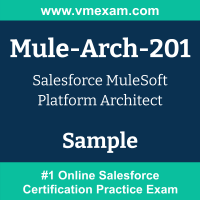01. Which two actions are needed to create a custom alert for a Mule application deployed to CloudHub?
(Choose two.)
a) Add Anypoint Connector for CloudHub to the Mule application
b) Configure the custom application alert in Runtime Manager
c) Configure an email server for the alert notification to be sent
d) Enable alerts in Runtime Manager
02. A MuleSoft architect has defined requirements for a project. Which three tools can convert the project requirements into capabilities to design, validate, and publish APIs?
(Choose three.)
a) Exchange
b) Anypoint Monitoring
c) Design Center
d) Mocking service
e) Runtime Manager
f) API libraries
03. In which scenario is the use of Object Store (OS) most recommended with CloudHub?
a) Storing transient application data
b) Long-term archival of data
c) Storing user session data
d) Backup for on-premises databases
04. According to the API-led connectivity approach MuleSoft recommends, what is a best practice when building system APIs?
a) Build an Enterprise Data Model (Canonical Data Model) for all back-end systems and apply it to system APIs
b) Expose the details of the API implementation's interaction with the back-end system to API clients
c) Expose the metadata of the back-end system
d) Document the system API using an easily consumable asset like a RAML definition
05. What is a typical result of using a fine-grained, rather than a coarse-grained, API deployment model to implement a given business process?
a) An overall lower usage of resources because each fine-grained API consumes fewer resources
b) A higher number of discoverable, API-related assets in the application network
c) A better response time for the end user as a result of the APIs being smaller in scope and complexity
d) A decrease in the number of connections within the application network supporting the business process
06. How should a customer using Runtime Fabric on self-managed Kubernetes monitor their worker node health and core capacity?
a) Use Runtime Fabric Ops Center
b) Use tooling provided by the Kubernetes provider
c) Use the Infrastructure tab within Anypoint Monitoring
d) Use Anypoint Platform APIs to retrieve real-time node performance data
07. Which scenario benefits from horizontal scaling?
a) An API proxy that receives frequent but small payloads
b) An API that receives infrequent but large JSON payload
c) An API that performs heavy data transformation
d) API implementations that are stateful in nature
08. Compare and contrast CloudHub networking when integrated with customer-owned Amazon VPCs and on-premises data centers. What is a key advantage of using Amazon VPCs?
a) Faster deployment speeds
b) Better security due to physical isolation
c) Lower latency compared to on-premises connections
d) Easier scalability
09. The responses to some HTTP requests can be cached depending on the HTTP verb used in the request. According to the HTTP specification, what are the safe methods to use?
a) GET, HEAD, POST
b) GET, OPTIONS, HEAD
c) PUT, POST, DELETE
d) GET, PUT, OPTIONS
10. A team working at a multinational bank introduced a new System API into their environment. What are two reasons the team made this decision?
(Choose two.)
a) Payment requests coming through the system had to be routed to a new fraud engine that was introduced at the bank
b) The administration system did not authorize requests and was having data erroneously modified due to unauthorized requests
c) An external vendor that integrated with the bank's systems changed their client from one that interacted with SOAP interfaces to one that required RESTful interfaces
d) The administration system's interface utilized an overly complex model, the majority of which was not applicable to the bank's business
 We have prepared Salesforce MuleSoft Platform Architect (Mule-Arch-201) certification sample questions to make you aware of actual exam properties. This sample question set provides you with information about the MuleSoft Platform Architect exam pattern, question formate, a difficulty level of questions and time required to answer each question. To get familiar with Salesforce Certified MuleSoft Platform Architect exam, we suggest you try our Sample Salesforce Mule-Arch-201 Certification Practice Exam in simulated Salesforce certification exam environment.
We have prepared Salesforce MuleSoft Platform Architect (Mule-Arch-201) certification sample questions to make you aware of actual exam properties. This sample question set provides you with information about the MuleSoft Platform Architect exam pattern, question formate, a difficulty level of questions and time required to answer each question. To get familiar with Salesforce Certified MuleSoft Platform Architect exam, we suggest you try our Sample Salesforce Mule-Arch-201 Certification Practice Exam in simulated Salesforce certification exam environment.